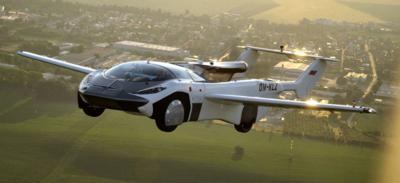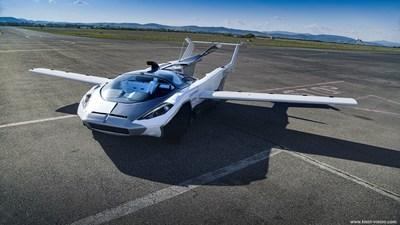Wed, Jan 26, 2022
Testing Moves Forward for Exotic Airborne Supercar
Flying cars, long seen as a hallmark of futuristic aeronautical technology, may finally be on the horizon.

AirCar's prototype has been given its first airworthiness certification from the Slovakian Transport Authority, making it the first of its kind to achieve EASA standards. The testing process took 70+ hours of flight and more than 200 takeoff and landing cycles.
The AirCar reportedly functions throughout the full range of flight and performance maneuvers required, while demonstrating "an astonishing static and dynamic stability in the aircraft mode." The aircraft is powered by a hybrid power system built around a 1.6L BMW engine. In a market segment with a number of historic projects, the flying car has been attempted before, but rarely with such panache and feasibility. With the wings folded into its body, the tail passes for an exuberant aerodynamic wing not unlike the legendary Superbird's, the sleek, lithe form looking just like any other high-end exotic car. The propeller in the back, of course, gives the charade away, but passing for a car is a trick few projects have been able to pull off. With approval given, the AirCar shows promise in its journey towards production.

“AirCar certification opens the door for mass production of very efficient flying cars. It is official and the final confirmation of our ability to change mid-distance travel forever,” said Professor Stefan Klein, the inventor, leader of the development team and the test pilot. “50 years ago, the car was the epitome of freedom,” says Anton Zajac, the project cofounder. “AirCar expands those frontiers, by taking us into the next dimension; where road meets sky.”
“Professor Stefan Klein is the world leader in the development of user-friendly Flying Cars. His latest (fifth) version is the pinnacle achievement in the new category of flying cars!” said Dr. Branko Sarh, Boeing senior technical fellow. “The automated transition from road vehicle into an air vehicle and vice versa, deploying/retracting wings and tail is not only the result of pioneering enthusiasm, innovative spirit and courage; it is an outcome of excellent engineering and professional knowledge,” he said after the project's first point to point flight test last year.
More News
He Attempted To Restart The Engine Three Times. On The Third Restart Attempt, He Noticed That Flames Were Coming Out From The Right Wing Near The Fuel Cap Analysis: The pilot repor>[...]
Make Sure You NEVER Miss A New Story From Aero-News Network Do you ever feel like you never see posts from a certain person or page on Facebook or Instagram? Here’s how you c>[...]
From 2009 (YouTube Edition): Leading Air Show Performers Give Their Best Advice for Newcomers On December 6th through December 9th, the Paris Las Vegas Hotel hosted over 1,500 air >[...]
Aero Linx: NASA ASRS ASRS captures confidential reports, analyzes the resulting aviation safety data, and disseminates vital information to the aviation community. The ASRS is an i>[...]
“For our inaugural Pylon Racing Seminar in Roswell, we were thrilled to certify 60 pilots across our six closed-course pylon race classes. Not only did this year’s PRS >[...]
 NTSB Final Report: Rutan Long-EZ
NTSB Final Report: Rutan Long-EZ ANN FAQ: Turn On Post Notifications
ANN FAQ: Turn On Post Notifications Classic Aero-TV: ICAS Perspectives - Advice for New Air Show Performers
Classic Aero-TV: ICAS Perspectives - Advice for New Air Show Performers ANN's Daily Aero-Linx (06.28.25)
ANN's Daily Aero-Linx (06.28.25) Aero-News: Quote of the Day (06.28.25)
Aero-News: Quote of the Day (06.28.25)




